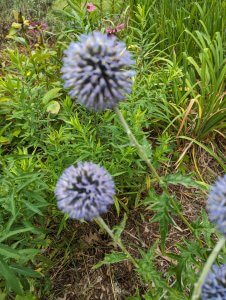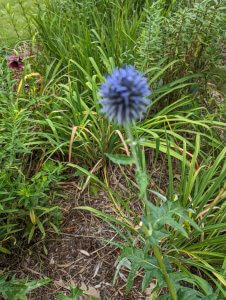Gardens and globes go together. Beginning in spring and progressing through the growing season, the purple or white globes of various allium species stand tall. Annabelle-type hydrangeas are prized for their large, globular flowerheads. Formal gardens boast shrubs clipped into tight lollipop shapes, and retro gardeners decorate with old-fashioned gazing globes.
Given the enduring allure of rounded shapes, it is no wonder that perennial globe thistle, or echinops species have long been fashionable.

As is often the case in horticulture, the common name, “globe thistle,” is a misnomer. The flowers are definitely globe-shaped, but echinops are not a thistle at all. Despite its membership in the vast Compositae or daisy plant family, the blooms are not daisy-like. To add to the general confusion, globe thistles bear ferocious-looking gray-green foliage on lanky stalks, with leaves that look like the result of an aggressive dandelion/thistle mash-up. Fortunately, their forbidding appearance only marks them as tools in the arsenal of deception that Mother Nature uses to make gardeners’ lives interesting. The prickles are not particularly lethal, and the undersides are soft, touchable, and light-colored.
The “globes” that give globe thistle its name are actually orbs of individual tubular flowers clustered into tight, round shapes. Some of the most common are ping pong ball-size, but the flowerheads may be smaller or larger depending on species and variety. White globe thistles are available commercially, but the blue-flowered varieties are most common and range in tone from powder blue to a rich, dark shade. The blooms may also have a sweet fragrance.
Add globe thistles’ virtues together, and you come up with tough, perennial performers that make great garden exclamation points. Depending on the size of your beds or borders and the variety you choose, they generally work best at the middle to back of the border.
If you are a container gardener, you can grow echinops as a stand-alone specimen, or as the “thriller” in a “thriller/filler/spiller” arrangement in a large container. The plants will be perfectly happy, even if you occasionally miss watering them.

Like their common thistle namesakes, echinops are summer plants, shining from July through September. The flowerheads dry intact on the stalks and make excellent everlasting specimens for indoor arrangements. If you want to speed the drying process and preserve color, pick the stems while the flowers are blooming and hang them upside down in a cool, airy place until they are thoroughly dried.
Several echinops species dominate the retail market, including Echinops ritro, the small globe thistle. “Small” refers to the relative width of the flowerheads, not the plant’s overall size. One of the best ritro varieties is the English-bred favorite, ‘Veitch’s Blue’, with blue-purple flowers on plants that grow up to four feet tall and two feet wide. Another ritro variety, ‘Platinum Blue’, grows up to 36 inches tall, with bright blue-purple blooms. Echinops bannaticus, the “blue globe thistle”, is another tall plant, native to Romania. ‘Blue Glow’ is a bannaticus variety, featuring steely blue flowerheads. ‘Taplow Blue’, also a bannaticus, boasts steel-blue globes on four to five foot stems. Some merchandisers also offer Echinops sphaerocephalus, known as the “great globe thistle”. Pair any of the blue echinops with the white-flowered sphaerocephalus ‘Arctic Glow’, which is a little shorter, but provides great color contrast. Shorter still is the equally white-flowered ‘Star Frost’.
Globe thistles prefer sunny conditions, but will perform in light shade, and actually do best in lean, well-drained soil. Amend heavy clay with sand or grit to ensure that necessary drainage. While the plants don’t like desert conditions, they do not need the constant moisture and fertilizer fixes demanded by other summer bloomers like annuals and roses.
“Echinops” is from the Latin word meaning “hedgehog”. Most likely the great plant taxonomist Linnaeus thought the flowerheads looked a little like blue versions of the small animals.
Echinops are in bloom in July, along with many of their daisy family relations. More flowers will appear as the summer progresses, aided by deadheading or cutting stems for fresh or dried arrangements.
Good local garden centers may have some plants on the pallets. If not, check specialty nurseries online, where choices abound.

